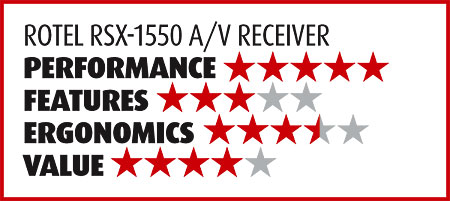Rotel RSX-1550 A/V Receiver Page 2
Thunder, the View, the Streets
Tropic Thunder, in Dolby TrueHD, opens with a war scene that’s satiric but no less bombastic. “Noise—good,” I wrote in my notes to remind myself of how remarkably painless this was. “No nasty stuff on the top end,” I added, just in case the foregoing wasn’t enough. I was also struck at how much midbass presence the receiver mustered with the quintet of 7-inch Paradigm woofers. The bottom end seemed more substantial than on most receivers I’ve recently used for full-range listening. And all of them had higher power ratings than the Rotel’s 75 watts per channel. There were moments (not a lot, but some) when I’d have sworn a subwoofer was connected.

Lakeview Terrace’s psycho-neighbor scenario depends on quiet menace to build its disturbing dramatic momentum. The receiver’s low-resolution prowess helped with mood-setting crickets and the occasional distant dog bark. Moderate all-channel activity, such as a brief scene in a Los Angeles ghetto, was convincing. The street-noise ambience was unusually realistic, partly due to Dolby TrueHD and a good mix, no doubt. Again, the receiver’s bottom end got high marks for the low synthesized pulses that are a staple of ominous movie soundtracks. No matter how much I tried to distance myself—I’m working, I’m taking notes, this is my job—the movie left me unsettled and emotionally drained.
The packaging of Step Up 2: The Streets identifies the soundtrack as Dolby TrueHD, but the receiver’s display identified it as PCM. This probably mattered less than the fact that effective use of surround wasn’t even on the filmmakers’ to-do list. In what should have been emotionally charged dance-floor numbers, the too-compressed music washed over too-low swatches of crowd noise to create a bland sound that turned my system into a TV speaker. There was little attempt to mix club or street ambience into the music. For an example of how this might be done more aggressively and right, see the Eminem vehicle 8 Mile. Overall, the Streets mix was oddly flat, dispassionate, and even more annoying than the hokey plot. It left street-wise choreography and exuberant solo and ensemble dancing as the movie’s only attractive elements. Watch it with the sound off, and you might like it.
On Rye, with Mustard
The Rotel made The Move’s Shazam (on vinyl) as satisfying as a hot pastrami sandwich. This band’s pioneering mix of first-generation heavy metal, exuberant power pop, Roy Wood originals, and lovingly crafted cover versions remained exhilarating. Nothing about Bev Bevan’s meaty drum sound—sometimes doubletracked to evoke the rolling thunder of a herd of tanks—left me wishing for a sub. The Move wanted this LP to have a luxuriously thick and multi-textured sound. To achieve that, they mixed in small but effective amounts of out-of-phase information. So the Dolby Pro Logic II music mode provided a wraparound effect with some percussive, guitar, and vocal elements. Perhaps it speaks well of the Rotel’s midrange that I was bowled over, for the first time, by the gorgeous vibrato and skillful enunciation of lead singer Carl Wayne, who was at the peak of his powers in the album-ending cover of Tom Paxton’s “The Last Thing on My Mind.”
My copy of Sarah Vaughan’s Golden Hits!!! is a $1 sidewalk LP—a little crackly here and there but mostly in good condition. Even surrounded by intermittently goofy arrangements and stuck in an echo chamber, Sassy remains a joy to listen to, especially for the grace, virtuosity, and feeling she displays on “Autumn in New York.” The 1958 release is nominally stereo. Some tracks really are, but others are in rechanneled stereo. Record companies of the 1950s and ’60s thought this would make perfectly good mono recordings more palatable to the Mad Men–era public, with its newly acquired stereo phonographs. I can listen to early stereo ping-pong mixes, but rechanneled two-channel is just excruciating. There was nothing to do but dive for the Mono button on the receiver’s front panel and flip back and forth between stereo and mono as needed. Not all receivers have this feature, at least in such an accessible form. It’s one of the perks of buying an audiophile receiver.
I returned to the digital world for Sony Classical’s soundtrack CD of Defiance, a movie score written by James Newton Howard and graced by a great violin soloist, Joshua Bell. Against a monochromatic background of bleak and brooding strings, Bell injects a human element and plenty of tone color. My eyes wandered to a nearby PC monitor, which was showing vacation pictures of Munich. It’s actually a fairly colorful and jolly place, but the music seemed to bring out the undercurrent of its troubled soul. Spoiled as I am by multichannel SACDs and Blu-ray Dolby TrueHD movie soundtracks, I had to admit that the DPLII treatment of this stereo CD formed an involving, well-defined, and entirely natural soundfield. I’ve always noticed that Rotel products are flattering to CDs that are well recorded and mastered, as in this case. However, given substandard material, they don’t lie.
Medium-sized manufacturers like Rotel are often referred to—admiringly, as far as I’m concerned—as the low end of the high end. The RSX-1550 has the refinement (if not the rated power) that I normally associate with good separates. If you want five channels of great sound, HDMI 1.3a connectivity, and a genuinely attractive look, this receiver delivers on all three counts.






























































